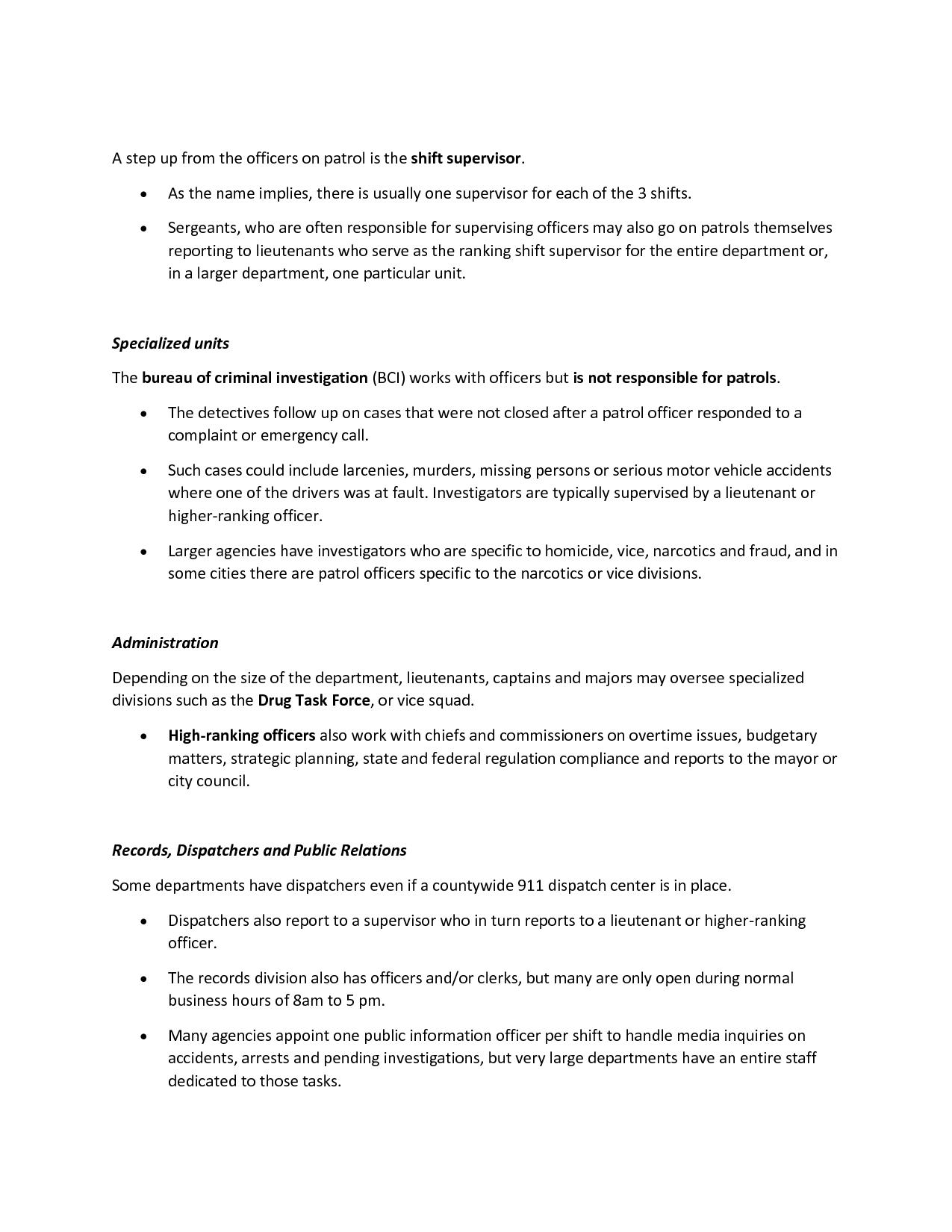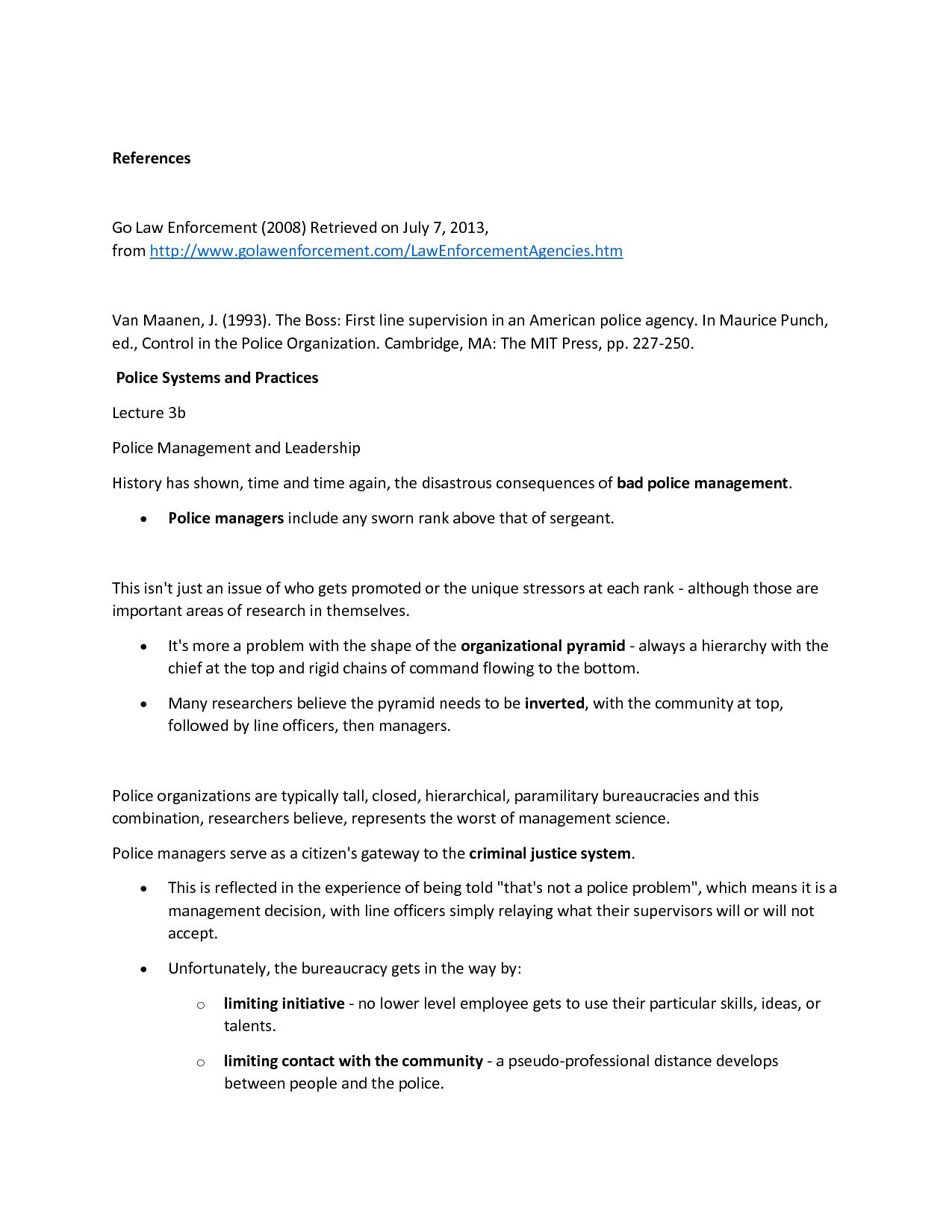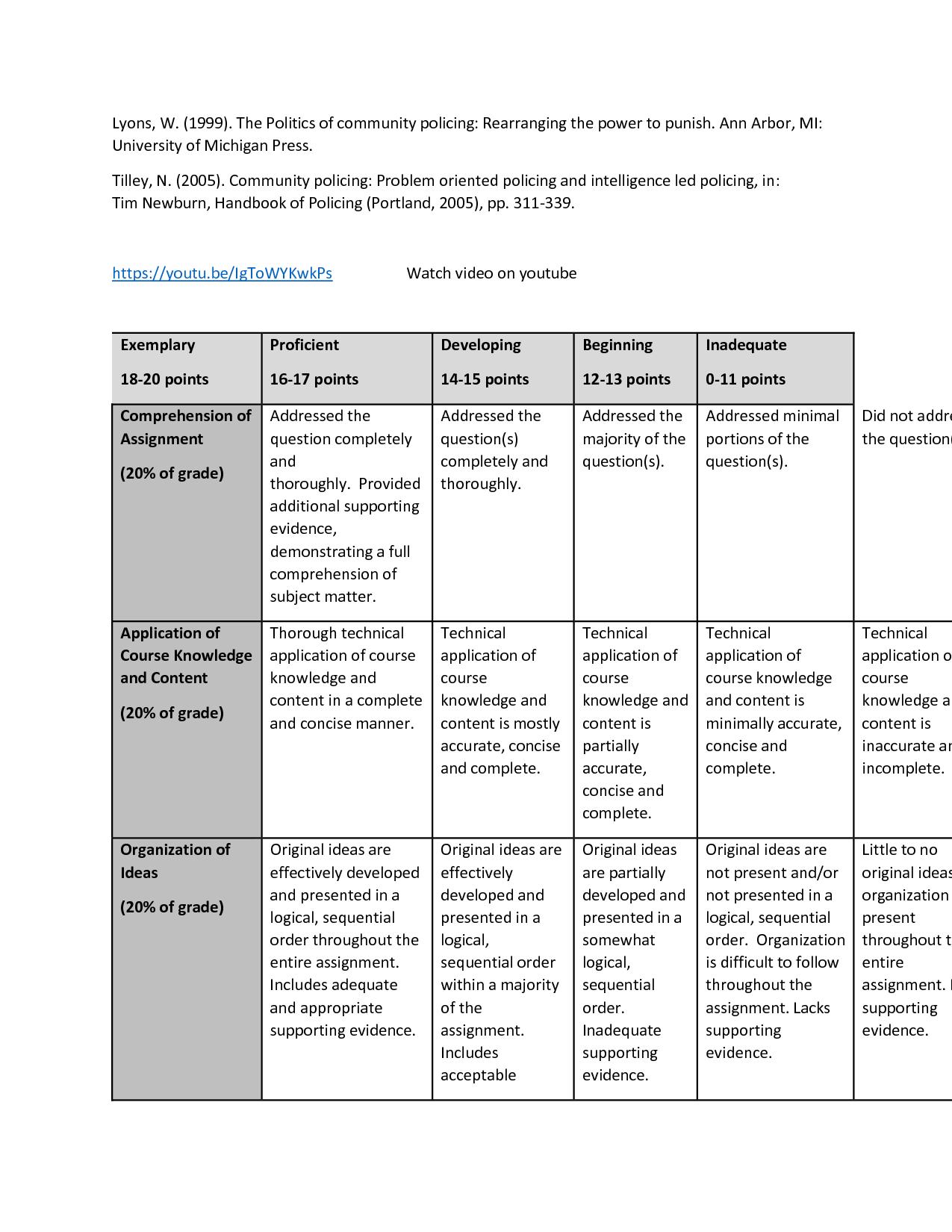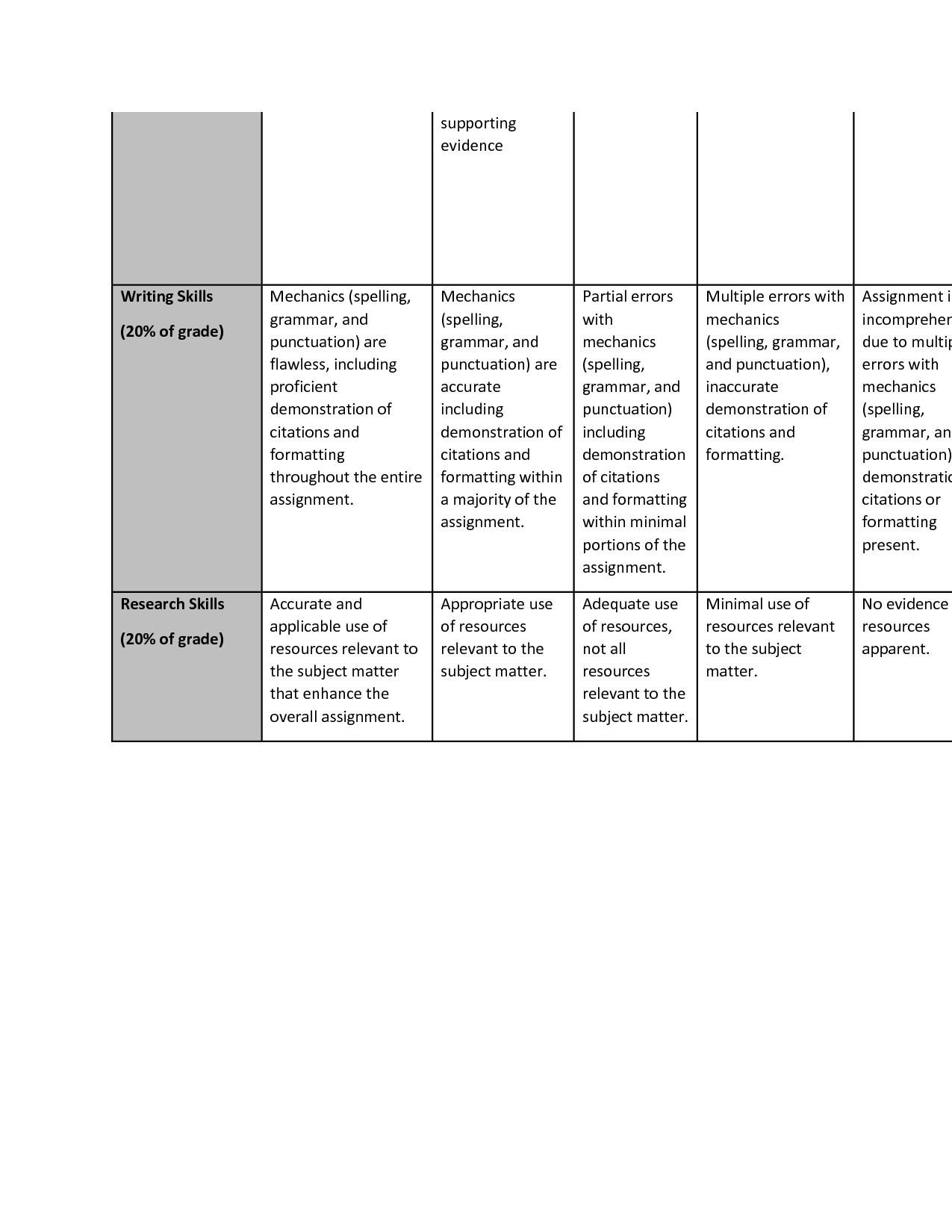Answered step by step
Verified Expert Solution
Question
1 Approved Answer
Although many police agencies today are rethinking their organization and goals, many still function in a hierarchical manner. Write a 500-750 word paper that
Although many police agencies today are rethinking their organization and goals, many still function in a hierarchical manner. Write a 500-750 word paper that identifies the chain of command and examines how problems can arise within the organizational structure of a police agency. Support your argument with at least two outside references. Be sure to cite your resource(s). Only the body of the paper will count toward the word requirement. You may use your textbook and other outside sources as needed. Police Systems and Practices Lecture 3a Notes Law Enforcement Agencies There are many different roles in which local law enforcement agencies take part in on a daily basis. The duties, functions and responsibilities of local law enforcement agencies are broken down into many different roles. Local law enforcement agencies are in place to provide routine patrol of the communities within their jurisdictions, provide emergency services, maintain records, uphold traffic enforcement laws, conduct criminal investigations/ planning and analysis, maintain property, keep within a budget, provide laboratory or forensic investigation, create agendas, provide detention for adults and juveniles, provide public information, community services, alcoholic testing, crime prevention communications, community relations, internal affairs, equipment maintenance and supply, and much more. State law enforcement agencies are charged with many different roles as well. State police are charged with keeping the state's highways, rural areas, and many other areas within their state safe. State police are also charged with keeping motor vehicles inspected per U.S. regulation. Many other agencies within the state as well share many other roles with other state and local law enforcement agencies. The state law enforcement agencies also conduct criminal investigations, public relations and community initiatives. The difference between local and state law enforcement agencies is their resources, staff, in some cases budgets, and jurisdictions. Many federal law enforcement agencies are in place to work with certain types of crimes. For example, three of the most well known agencies are the Federal Bureau of Investigations, United States Marshal Service (USMS), and United States Border Patrol (USBP). The FBI is responsible for eight major criminal investigations and they include counterterrorism, counterintelligence, cyber crime, public corruption, civil rights, organized crime, white-collar crime, and major thefts/violent crimes. The USMS is accountable for apprehending fugitives, protecting federal judges and courts, managing & selling assets, transporting prisoners, managing prisoners, protecting witnesses, serving court documents, and conducting criminal investigations. The USBP now U.S. Customs and Border Protection is charged with the responsibilities of preventing the illegal entry of aliens and goods whereas facilitating lawful travel and trade. These federal law enforcement agencies often work in conjunction on several different taskforces to effectively investigate and prosecute those who commit crimes in the United States. Local Police Organizational Structure Most local police departments whether large or small are organized in the same basic structure. Most departments have 3 shifts 7 days a week, 24 hours a day. There are typically more officers on duty during the daytime and fewer at night with specialists and detectives on call in very small departments that may have a few officers on patrol at night. Officers out on patrol have a specific area or zone they cover. Some officers work the same zones or "beat" for an indefinite period of time, while others may work an area for a certain period of time and then switch to some other area. A step up from the officers on patrol is the shift supervisor. Specialized units The bureau of criminal investigation (BCI) works with officers but is not responsible for patrols. The detectives follow up on cases that were not closed after a patrol officer responded to a complaint or emergency call. . As the name implies, there is usually one supervisor for each of the 3 shifts. Sergeants, who are often responsible for supervising officers may also go on patrols themselves reporting to lieutenants who serve as the ranking shift supervisor for the entire department or, in a larger department, one particular unit. Administration Such cases could include larcenies, murders, missing persons or serious motor vehicle accidents where one of the drivers was at fault. Investigators are typically supervised by a lieutenant or higher-ranking officer. Depending on the size of the department, lieutenants, captains and majors may oversee specialized divisions such as the Drug Task Force, or vice squad. Larger agencies have investigators who are specific to homicide, vice, narcotics and fraud, and in some cities there are patrol officers specific to the narcotics or vice divisions. . Records, Dispatchers and Public Relations Some departments have dispatchers even if a countywide 911 dispatch center is in place. Dispatchers also report to a supervisor who in turn reports to a lieutenant or higher-ranking officer. High-ranking officers also work with chiefs and commissioners on overtime issues, budgetary matters, strategic planning, state and federal regulation compliance and reports to the mayor or city council. The records division also has officers and/or clerks, but many are only open during normal business hours of 8am to 5 pm. Many agencies appoint one public information officer per shift to handle media inquiries on accidents, arrests and pending investigations, but very large departments have an entire staff dedicated to those tasks. References Go Law Enforcement (2008) Retrieved on July 7, 2013, from http://www.golawenforcement.com/Law Enforcement Agencies.htm Van Maanen, J. (1993). The Boss: First line supervision in an American police agency. In Maurice Punch, ed., Control in the Police Organization. Cambridge, MA: The MIT Press, pp. 227-250. Police Systems and Practices Lecture 3b Police Management and Leadership History has shown, time and time again, the disastrous consequences of bad police management. Police managers include any sworn rank above that of sergeant. This isn't just an issue of who gets promoted or the unique stressors at each rank - although those are important areas of research in themselves. It's more a problem with the shape of the organizational pyramid - always a hierarchy with the chief at the top and rigid chains of command flowing to the bottom. Police organizations are typically tall, closed, hierarchical, paramilitary bureaucracies and this combination, researchers believe, represents the worst of management science. Police managers serve as a citizen's gateway to the criminal justice system. This is reflected in the experience of being told "that's not a police problem", which means it is a management decision, with line officers simply relaying what their supervisors will or will not accept. Many researchers believe the pyramid needs to be inverted, with the community at top, followed by line officers, then managers. Unfortunately, the bureaucracy gets in the way by: O limiting initiative - no lower level employee gets to use their particular skills, ideas, or talents. O limiting contact with the community - a pseudo-professional distance develops between people and the police. Delegation of authority is supposed to make the system work. The chief delegates authority to commanders, who delegate authority to managers, and so on down the line. Written guidelines in the form of policies and procedures also regulate conduct. . O limiting contact within the department - employees in one area don't know what employees in the other area are up to. However, studies suggest that delegation works best in small-to-medium departments where everyone is alike and a generalist. Large police departments have precincts, divisions, bureaus, and specialists where authority cannot be easily delegated. The fact that real authority only passes down thru those who fit the mold of uniformed street cop generalist is a factor that inhibits any specialization or progress in policing. Since different communities have different values, customs and concerns, research suggests that the police officers assigned to them need to be flexible enough to adapt their police-public partnership approaches to the specific conditions of the neighborhoods in which they work. As the officers on the beat are most familiar with the community's needs and capacities, they should have the autonomy to act at their own discretion when they put police policy into action (for instance when initiating contacts, conducting problem-solving and using resources). Decentralization is closely linked to the transformation of responsibilities of all police officers, with subordinate ranks becoming more self-directing and supervisors and senior ranks assuming a coordinating, guiding and supporting role encouraging front-line officers to be disciplined but creative in their initiative-taking, and ensuring that they have the resources necessary for effective problem- solving. Furthermore, communication within the police should shift from a predominantly top- down approach to a style with more emphasis on a bottom-up approach, where front-line officers transmit the community's concerns and requests to their supervisors and the higher management. References This two-way communication should also lead to a collaborative style ecision-making. Guyot, D. (2009). Bending granite: Attempts to change the rank structure of American police departments. Journal of Police Science and Administration, 37:253-284. Lyons, W. (1999). The Politics of community policing: Rearranging the power to punish. Ann Arbor, MI: University of Michigan Press. Tilley, N. (2005). Community policing: Problem oriented policing and intelligence led policing, in: Tim Newburn, Handbook of Policing (Portland, 2005), pp. 311-339. https://youtu.be/IgToWYKwkPs Exemplary 18-20 points 16-17 points Comprehension of Addressed the Assignment (20% of grade) Application of Course Knowledge and Content (20% of grade) Proficient Organization of Ideas (20% of grade) Watch video on youtube question completely and thoroughly. Provided additional supporting evidence, demonstrating a full comprehension of subject matter. Thorough technical application of course knowledge and content in a complete and concise manner. Original ideas are effectively developed and presented in a logical, sequential order throughout the entire assignment. Includes adequate and appropriate supporting evidence. Developing 14-15 points Addressed the question(s) completely and thoroughly. Technical application of course knowledge and content is mostly accurate, concise and complete. Original ideas are effectively developed and presented in a logical, sequential order within a majority of the assignment. Includes acceptable Beginning 12-13 points Addressed the majority of the question(s). Technical application of course Original ideas are partially developed and presented in a somewhat logical, sequential order. Inadequate 0-11 points Inadequate supporting evidence. Addressed minimal portions of the question(s). knowledge and and content is content is partially accurate, concise and complete. Technical application of course knowledge minimally accurate, concise and complete. Original ideas are not present and/or not presented in a logical, sequential order. Organization is difficult to follow throughout the assignment. Lacks supporting evidence. Did not addre the question Technical application o course knowledge a content is inaccurate ar incomplete. Little to no original ideas organization present throughout t entire assignment. supporting evidence. Writing Skills (20% of grade) Research Skills (20% of grade) Mechanics (spelling, grammar, and punctuation) are flawless, including proficient demonstration of supporting evidence Accurate and applicable use of resources relevant to the subject matter that enhance the overall assignment. Mechanics (spelling, grammar, and punctuation) are accurate including citations and formatting citations and throughout the entire formatting within assignment. a majority of the assignment. demonstration of including Partial errors with mechanics (spelling, grammar, and punctuation) Appropriate use of resources relevant to the subject matter. citations and demonstration formatting. of citations and formatting within minimal portions of the assignment. Multiple errors with Assignment i incompreher due to multip mechanics (spelling, grammar, and punctuation), inaccurate demonstration of errors with mechanics (spelling, grammar, an punctuation) demonstratic Adequate use of resources, not all resources relevant to the subject matter. Minimal use of resources relevant to the subject matter. citations or formatting present. No evidence resources apparent.
Step by Step Solution
★★★★★
3.32 Rating (149 Votes )
There are 3 Steps involved in it
Step: 1
Police agencies around the globe mostly use a hierarchical chain of command As one ascends to a higher rank there are more responsibilities and duties to accomplish The chain of command is critical to ...
Get Instant Access to Expert-Tailored Solutions
See step-by-step solutions with expert insights and AI powered tools for academic success
Step: 2

Step: 3

Ace Your Homework with AI
Get the answers you need in no time with our AI-driven, step-by-step assistance
Get Started









